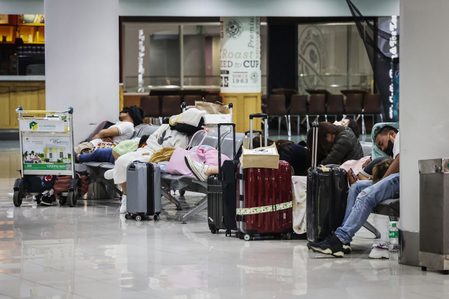SUMMARY
This is AI generated summarization, which may have errors. For context, always refer to the full article.

MANILA, Philippines – As the House and Senate took turns grilling officials over the New Year’s Day fiasco at the country’s premiere airport which affected more than 78,000 passengers, another defective air traffic system in the Philippines has come to light – this time, one that was never even used.
In a joint committee hearing on Thursday, January 12, senators turned their ire at the P511-million Manila Area Control Center (MACC), an air traffic control system previously procured by the government.
CAAP and the then-known Department of Transportation and Communications (DOTC) had purchased MACC in the late 2000s from the little-known Czechoslovakian firm CS-Soft.
“As of today, CS-Soft has yet to prove its name in the development of reliable and dependable air traffic management systems,” the Philippine Air Traffic Controllers Association (PATCA) said in a position paper in 2011.
Still, the MACC was touted as a transitional system for the CAAP to use while the aging Eurocat system was upgraded to the “state-of-the-art” Communications, Navigation and Surveillance Systems for Air Traffic Management (CNS/ATM).
But former CAAP director general William Hotchkiss II, who led the organization after the system had been acquired, said that MACC had flaws that rendered it unusable.
“It was a waste of money because we found it to be useless. … It was unsafe to use,” he said during the joint Senate committee hearing on Thursday, January 12.
In its position paper, PATCA further explained how the system’s computers would reboot unexpectedly and how data displayed on an aircraft’s position and altitude were “not credible.”
Worse, the broken MACC system also threatened to halt the country’s air traffic system upgrade plans altogether. The Commission on Audit (COA) had temporarily disallowed the CNS/ATM project in 2011, in part because the DOTC had just recently procured the defective MACC air traffic system. However, the CNS/ATM project was eventually permitted to continue when it was clear that a better air traffic management system was needed.
COA again flagged the MACC system, this time in an audit report released on July 14, 2022. The state auditor labeled the MACC as an “idle project” of the Department of Transportation (DOTr). The MACC System Project – Phase 1 and Phase 2 were both more than 99% accomplished according to COA, but the DOTr has yet to explain how the system might be used by other agencies.
“Management has not submitted any update on the potential utilization of the substantially completed Manila Area Control Center Phase I and II so as to deter further loss to the government due to technological obsolescence,” COA said in its audit report.
The DOTr had previously told COA that the unused system could be transferred to the Philippine Air Force or Philippine Coast Guard and reconfigured for specialized military use.
“Management’s actions on proposals, transfers, agreements and/or communications were, however, not furnished to the Audit Team to date,” the state auditor said.
Here’s a timeline of the CAAP’s system upgrade and what it looks like:
| 1990s | CAAP begins conceptualizing a new air traffic management system to replace its Eurocat system, which was implemented in 1996. |
| September 2009 | Phase 1 of the MACC project commences. |
| February 2010 | Phase 1 of the MACC project is completed. |
| June 2010 | Phase 2 of the MACC project commences. |
| November 2010 | Phase 2 of the MACC project is completed. The DOTC also awards the first work package to the Sumitomo-Thales joint venture. This includes the design and construction of the Air Traffic Management Center and ATM Automation System, and the final integration of the whole CNS/ATM system. |
| April 2011 | The DOTC awards the second package to the joint venture, which involves the design and construction of a surveillance and communication system. |
| May 2011 | The COA disallowed the advance payment of P58.92 million for the new CNS/ATM system. |
| December 2011 | CAAP commences the construction of the Air Traffic Management Center. |
| May 2013 | COA lifts the notice of disallowance against the DOTC’s advance payment. |
| January 2015 | CAAP completes a P159.9-million upgrade of its air traffic management system while transitioning to the new CNS/ATM system. |
| January 2017 | CAAP estimates that the CNS/ATM system is 92% complete and would be ready by June 2017. |
| January 2018 | President Rodrigo Duterte inaugurates the CNS/ATM system and estimates that it would be fully operational within the year. |
| July 2019 | Almost nine years after work began on the system, CAAP announces that the CNS/ATM system is finally operational and ready to begin “comprehensive operations.” |
Right now, the future of the MACC remains unclear. Former CAAP chief Hotchkiss said that he was unaware of the current status and functionality of the system.
The current CAAP Director General, Manuel Tamayo, also confirmed that the MACC was never used.
“That MACC system never went online kasi ang dami hong defects, ang daming issues (it had a lot of defects and many issues). It was not commissioned,” he said. – Rappler.com
Add a comment
How does this make you feel?





![[WATCH] Bamban POGO scandal: There’s a bigger fish than Alice Guo](https://www.rappler.com/tachyon/2024/07/inside-track-tcard-bamban-pogo.jpg?resize=257%2C257&crop=435px%2C0px%2C1080px%2C1080px)
There are no comments yet. Add your comment to start the conversation.